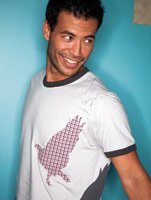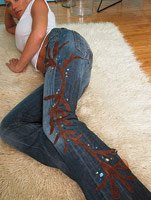Local Company Brings Die Cutting In-House
Tarina Tarantino found a new helper for her studio.
The Los Angeles jewelry and hair accessories designer recently bought a die-cutting machine that lets her produce, by hand, flowers, stars, butterflies and other shapes out of felt, plastic, vinyl and various fabrics. She layered the pieces under crystals, Lucite and resin, creating what she called “funky” and “avant-garde” brooches that will retail at $300 and higher.
Had she stuck with her routine of hiring suppliers who made three-dimensional patterns based on her sketches, it would have taken her two weeks instead of the one day spent using the hand-operated machine. Though the die cutter yields one-dimensional shapes, it is easier for the designer to experiment and create couture, including Fall’s in-demand brooches. “I will get a couple of them in my store in Milan before Christmas,” Tarantino said.
She said she also envisions using the die cutter to make invitations for shows and markets. “It was an interesting tool to make one-of-a-kind pieces,” she noted.
The tool Tarantino used was manufactured by Ellison, based in Lake Forest, Calif., an established player in the $6 billion paper-crafts sector but a newcomer to the fashion industry. The company’s heavy table-top machine uses a steelrule die to cut shapes out of fabric, leather, thin metal and generally any material that industrial scissors can shear.
Designers who have used the Ellison machine have found that it helps them ride the growing handcrafted trend, which has already inspired apparel makers including Guess? Inc. and Petro Zillia to affix appliqueacute;s on everything from button- down shirts to tees. Designers also said they can shave weeks off the process of working with trim houses that make fabric cutouts and samples. By handling the die cutting, designers can work on their own schedule, take clothes to market faster, and, through a service offered by Ellison, put a copyright and trademark on customized dies.
Saving on trips to trim houses appeals especially to independent designers. “You have a limited budget for R&D,” said John Montgomery, the Los Angeles–based creative director of the Scam-Co line of comic book–influenced T-shirts.
Montgomery, who created a Web site for Ellison, made a lined T-shirt featuring a hawk cutout and appliqueacute;s, among other garments, with the machine. He estimated that a trim house would have charged about $350 for die cutting and sampling and would have taken at least two weeks to complete the hawk shirt order. The process from ordering the $60 die from Ellison to sewing the shirt lasted four days, he said.
Ellison offers three models of its machine, which cut shapes up to 6, 10 and 13 inches wide. Machine prices range from $300 to $595, and die prices start at $20. In addition to its more than 8,000 stock dies, Ellison also offers a custom diemaking service, which charges $50 to $180 per die, depending on the size and intricacy of the design, and requires two days, said Ellison President Kent Chesley. He said Ellison will help designers obtain copyrights and trademarks on customized dies. “Anything you create as a design is copyrightable,” Chesley said.
Tarantino liked that idea. “Anything that is a very unique shape I trademark and copyright it,” she said.
Ellison was founded 27 years ago by an art teacher and her husband. Today, the company stocks machines in about 80 percent of U.S. schools. Still owned by the founding family, Ellison employs fewer than 200 people. Chesley said Ellison was contacted first by designers who had used the machine.
After researching the fashion market, the company decided to develop programs such as licensing relationships with designers.
“We’re going to see what the industry demands,” Chesley said. He declined to disclose financial figures for the privately held company.
The Ellison equipment will not replace the business of trim houses. The machines can be used for companies producing limited quantities. For larger companies with bigger production runs, the machines can be used for sampling and testing new ideas.
Making appliqueacute;s in-house could divert a designer’s attention. Nony Tochterman, designer of Petro Zillia in Van Nuys, Calif., said she has been toying with appliqueacute;s on and off for several seasons. While she handles samples, duplicates, tiny production lines and limited editions within her 17-person organization, she usually sends out production to another company, typically in downtown Los Angeles.
“There is only so much a person can do,” she said. “In order to grow a company in an efficient, profitable way, you need to rely on contractors and subcontractors and build your network out.”
Mark Encinias, who recently moved to New York from Los Angeles to consult for Kangol’s Red line, spent nearly $600 on the smallest Ellison machine and some dies. He made a new hat with swirly side panels by dissecting light-tan and plaid hats and cutting a pattern based on the curve of the Kangol kangaroo’s back. He said the machine is good for limited runs of 50 items.
“You have to send it out once you get into production, when you’re doing 120 pieces or whatever,” Encinias said. “To me, it would be too much work.” —Khanh T.L. Tran
























